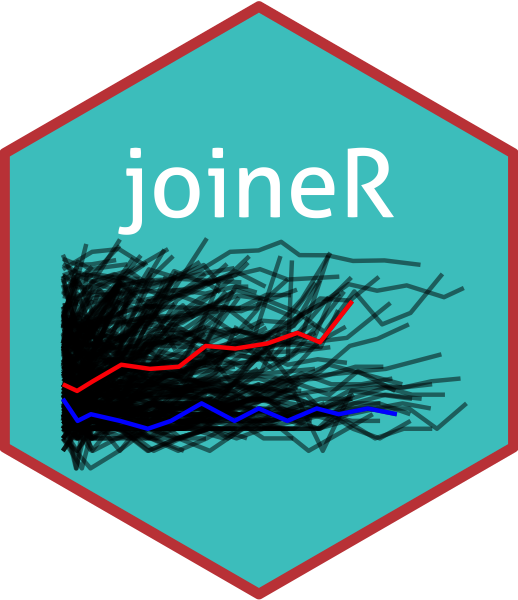
The hardware and bandwidth for this mirror is donated by dogado GmbH, the Webhosting and Full Service-Cloud Provider. Check out our Wordpress Tutorial.
If you wish to report a bug, or if you are interested in having us mirror your free-software or open-source project, please feel free to contact us at mirror[@]dogado.de.

The joineR package implements methods for analyzing data
from longitudinal studies in which the response from each subject
consists of a time-sequence of repeated measurements and a possibly
censored time-to-event outcome. The modelling framework for the repeated
measurements is the linear model with random effects and/or correlated
error structure (Laird and Ware, 1982). The model for the time-to-event
outcome is a Cox proportional hazards model with log-Gaussian frailty
(Cox, 1972). Stochastic dependence is captured by allowing the Gaussian
random effects of the linear model to be correlated with the frailty
term of the Cox proportional hazards model. The methodology used to fit
the model is described in Henderson et al. (2002) and Wulfsohn and
Tsiatis (1997).
The joineR package also allows competing risks data to
be jointly modelled through a cause-specific hazards model. The
importance of accounting for competing risks is detailed in Williamson
et al. (2007a,b). The methodology used to fit this model is described in
Williamson et al. (2008).
The joineR package comes with several data sets
including one the describes the survival of patients who underwent
aortic valve replacement surgery. The patients were routinely followed
up in clinic, where the left ventricular mass index (LVMI) was
calculated. To fit a joint model, we must first create a
jointdata object, which holds the survival, longitudinal,
and baseline covariate data, along with the names of the columns that
identify the patient identifiers and repeated time outcomes.
library(joineR)
#> Loading required package: survival
data(heart.valve)
heart.surv <- UniqueVariables(heart.valve,
var.col = c("fuyrs", "status"),
id.col = "num")
heart.long <- heart.valve[, c("num", "time", "log.lvmi")]
heart.cov <- UniqueVariables(heart.valve,
c("age", "hs", "sex"),
id.col = "num")
heart.valve.jd <- jointdata(longitudinal = heart.long,
baseline = heart.cov,
survival = heart.surv,
id.col = "num",
time.col = "time")With the creation of the heart.valve.jd object, we can
fit a joint model using the joint function. For this, we
need 4 arguments:
jointdata: the data object we created abovelong.formula: the linear mixed effects model formula
for the longitudinal sub-modelsurv.formula: the survival formula the survival
sub-modelmodel: the latent association structure.fit <- joint(data = heart.valve.jd,
long.formula = log.lvmi ~ 1 + time + hs,
surv.formula = Surv(fuyrs, status) ~ hs,
model = "intslope")
summary(fit)
#>
#> Call:
#> joint(data = heart.valve.jd, long.formula = log.lvmi ~ 1 + time +
#> hs, surv.formula = Surv(fuyrs, status) ~ hs, model = "intslope")
#>
#> Random effects joint model
#> Data: heart.valve.jd
#> Log-likelihood: -424.7084
#>
#> Longitudinal sub-model fixed effects: log.lvmi ~ 1 + time + hs
#> (Intercept) 4.993080959
#> time -0.007045486
#> hsStentless valve 0.055831384
#>
#> Survival sub-model fixed effects: Surv(fuyrs, status) ~ hs
#> hsStentless valve 0.7934551
#>
#> Latent association:
#> gamma_0 0.8211701
#>
#> Variance components:
#> U_0 U_1 Residual
#> 0.113577498 0.001766164 0.037071195
#>
#> Convergence at iteration: 9
#>
#> Number of observations: 988
#> Number of groups: 256Full details on the data and the functions are provided in the help documentation and package vignette. The purpose of this code is to simply illustrate the ease and speed in fitting the models.
joineR only models a single repeated measurement and a
single event time. If multiple longitudinal outcomes are available (see
Hickey et al., 2016), a separate package is available: joineRML.
This project was funded by the Medical Research Council (Grant numbers G0400615 and MR/M013227/1).

To install the latest developmental version, you
will need the R package devtools and to run the following
code
library('devtools')
install_github('graemeleehickey/joineR', build_vignettes = FALSE)Cox DR. Regression models and life-tables. J R Stat Soc Ser B Stat Methodol. 1972; 34(2): 187-220.
Henderson R, Diggle PJ, Dobson A. Joint modelling of longitudinal measurements and event time data. Biostatistics. 2000; 1(4): 465-480.
Hickey GL, Philipson P, Jorgensen A, Kolamunnage-Dona R. Joint modelling of time-to-event and multivariate longitudinal outcomes: recent developments and issues. BMC Med Res Methodol. 2016; 16(1): 117.
Laird NM, Ware JH. Random-effects models for longitudinal data. Biometrics. 1982; 38(4): 963-974.
Williamson PR, Kolamunnage-Dona R, Tudur-Smith C. The influence of competing-risks setting on the choice of hypothesis test for treatment effect. Biostatistics. 2007; 8(4): 689–694.
Williamson PR., Tudur-Smith C, Sander JW, Marson AG. Importance of competing risks in the analysis of anti-epileptic drug failure. Trials. 2007; 8: 12.
Williamson PR, Kolamunnage-Dona R, Philipson P, Marson AG. Joint modelling of longitudinal and competing risks data. Stat Med. 2008; 27: 6426–6438.
Wulfsohn MS, Tsiatis AA. A joint model for survival and longitudinal data measured with error. Biometrics. 1997; 53(1): 330-339.
These binaries (installable software) and packages are in development.
They may not be fully stable and should be used with caution. We make no claims about them.
Health stats visible at Monitor.